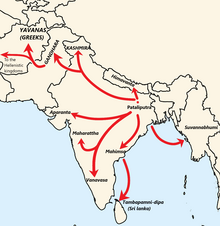Vibhajyavāda
| Part ofa serieson |
| EarlyBuddhism |
|---|
 |
Vibhajyavāda(Sanskrit;Pāli:Vibhajjavāda;traditional Chinese:Phân biệt thuyết bộ;;pinyin:fēnbiéshuō-bù) is a term applied generally to groups ofearly Buddhistsbelonging to theSthavira Nikāya,which split from theMahāsāṃghika(due either to the former attempting to make theVinayastricter, or the latter wishing to reform it; see:Sthavira Nikāyamain article) into two main groups: theSarvāstivādaand the Vibhajyavāda, of which the latter are known to have rejected both Sarvāstivāda doctrines (especially the doctrine of "all exists" ) and the doctrine ofPudgalavada(personalism).[1][2][3]During the reign ofAshoka,these groups possibly took part in missionary activity inGandhara,Bactria,Kashmir,South IndiaandSri Lanka.By the third century CE, they had spread inCentral AsiaandSouth-East Asia.[3]Their doctrine is expounded in theKathavatthu.
Nomenclature and etymology
[edit]The wordVibhajyavādamay beparsedintovibhajya,loosely meaning "dividing", "analyzing" andvādaholding thesemantic field:"doctrine", "teachings".[4]According to Andrew Skilton, the analysis of phenomena (Skt.dharmas) was the doctrinal emphasis and preoccupation of the Vibhajyavādins.[4]
According to A.K. Warder, they are called "distinctionists" because they make distinctions between dhammas that exist in the present and the past, and dhammas that don't exist in the past and the future (as opposed toSarvāstivāda).[5]This is supported by the explanation given by the 6th century Mahayana philosopherBhavaviveka.[6]
According toBhante Sujato,Vibhajyavādameans that the doctrine "distinguishes" (vibhajanto) the heterodox and orthodox views, particularly the non-Buddhist theory of a self (atman) as well as the theory of apudgala(or "person" similar to but distinct from theatman) of the Pudgalavadins (also known as theVātsīputrīya). The characteristic method used by the Buddha and early Buddhists to break down the idea of self was the method of analyzing (vibhajjati) the components of a person and investigating them to find that they do not possess the features that one could ascribe to a self. Thus, it would make sense that the term refers to "the Abhidhamma movement as an analytic approach to Dhamma in general, and as a critique of the ‘self’ in particular".[6]
Overview
[edit]
The Vibhajyavādins are a group of early Buddhist schools. According to theTheravadaaccount, this group rejected the Sarvastivada teachings at thethird Buddhist council(however modern scholars question the council narratives).[7][8]The name means "those who make distinctions," and include theKāśyapīya,MahīśāsakaandDharmaguptaka.[7]The Vibhajyavādins were strongly represented in south India, where they called themselvesTheriyas.They survived until the seventeenth century in south India, and inSri Lankathey became theTheravadins.[9]
The Vibhajyavādins rejected theSarvāstivādaclaim that alldhammas(principles, phenomena) exist in the past, present and future. Instead, they made a distinction between dhammas that "exist" and dhammas that do not exist, hence the name "distinctionists."[5]The Vibhajyavādins held that dhammas exist in the present, but not that they exist in the future. With regards to past dhammas, those wholesome or unwholesome dhammas that had already brought forth its fruit or effect were said not to exist, but those which had not yet brought forth a karmic effect could be said to have some efficacy.[2]TheSarvāstivādaVijñānakāyastates their position as defended by Moggaliputtatissa as: "The past and future are not; the present and the unconditioned exist."[10]
The Vibhajyavādins also held that out of all dhammas, onlyNirvanawas an unconditioned (asankhata) dhamma, against the view of theSarvāstivādawhich also held that space was an unconditioned dhamma.[11]Another difference with theSarvāstivādahinged on the issue of gradual versus sudden attainment. The Vibhajyavādins held that atstream entry,understanding of thefour noble truthscame at once (ekābhisamaya), while theSarvāstivādaasserted that this happened only gradually (anupubbābhisamaya).[12][13]Vibhajyavādins also asserted thatarhatscould not regress or fall back to a lower state once they attained arhatship.[12][14]The Vibhajyavādins also rejected the doctrine of the intermediate state between rebirths (antarabhava).[14]
Doctrines of the Vibhajyavādins can be seen in theKathāvatthu,traditionally attributed to elderMoggalipputtatissaby the Theravada.The earliest layer of this text could date as far as the reign ofAshoka.[7][6]However, neither the TheravādinKathāvatthunor theSarvāstivādaVijñānakāyacontain any reference to Vibhajyavāda as a separate school, indicating that perhaps during the time they were recorded there was not yet a formal schism between theSarvāstivādaand the Vibhajyavāda.[15][16]
TheVisuddhimaggaofBuddhaghosa,a fifth century Sri Lankan work meanwhile, mentions that theVisuddhimaggawas written at the request of Sanghaphala, "a member of the lineage of the Mahaviharasins, illustrious Theriyas, best of Vibhajjavādins".[3]
Branches
[edit]
The Vibhajyavādins are not recorded uniformly by early Buddhist traditions as being a distinct sect, nor being associated with any one period of time.[15]Some scholars believe that there was no separate "Vibhajyavāda" sect, but that the termvibhajyavādawas sometimes affixed to the name of a school to indicate that it differed from the main school on some doctrines.[17]In this sense, they would bevibhajyavādinsof that particular school.[17]
The name was applied to a variety of communities across the Indian subcontinent. The major ones were:[3]
- Dharmaguptaka,located mainly in the North-West of theIndian subcontinentbut also spreading along theCentral Asiantrade routes. According to Richard Salomon, this school was involved in missionary activity and was dominant inGandharaduring the first century CE.[3]
- Kāśyapīya,probably located in the same area as the Dharmaguptaka.
- Mahīśāsaka,as above but also in other parts of mainland India.
- Tambapaṇṇiya(Skt.Tamraparṇiyas, later known asMahāvihāravāsinsandTheravada), established in Sri Lanka (atAnuradhapura) but active also inAndhraand other parts ofSouth India(Vanavasa in modernKarnataka) and later acrossSouth-East Asia.Inscriptional evidence has been found inAmaravatiandNagarjunakonda.[3]
Bhante Sujato, in his overview of Dharmaguptaka and Mahāvihāravāsin schools, argues that the split between them was not due to any difference in doctrine or monastic discipline, but due to geographical distance.[18]
According toLS Cousins,the precursor to these schools was probably involved in missionary activity around the time ofAshokainto the regions ofKashmir,Gandhara,Bactria,AndhraandSri Lanka.[3]Cousins concludes:
Vibhajjavadins really were the school predominant in Ceylon and Gandhara at an early date, as well as being present, if not predominant, in other parts of Central Asia, China, South India and South-East Asia by around the third century CE at the latest. No other school had a comparable spread at this date.[3]
Sectarian views
[edit]TheMahaviharaTheravādinsofSri Lankaare descendants of theSthaviraVibhajyavādins inSouth Indiawho used thePalilanguage, differing somewhat from the northern Sthavira schools.[17]TheTheravādinshold that Vibhajyavāda was the favored doctrine during aBuddhist councilthat took place inPataliputraunderAshoka.As Gethin notes, the sources are rather confused on this matter however.[19]
TheSammatīyas(akaPudgalavadins) also mention the Vibhajyavādins.[15]According to the Sammatīya sect, the Vibhajyavādins developed from theSarvāstivādaschool.[15]
The SarvāstivādinAbhidharma Mahāvibhāṣa Śāstradescribes the Vibhajyavādins as being the type of heretics who "make objections, who uphold harmful doctrines and attack those who follow the authentic Dharma".[20][21]
TheMahāsāṃghikasaw the Vibhajyavādins as being offshoots from the root schism in Buddhism, which according to them produced three sects: theSthaviras,the Mahāsāṃghikas, and the Vibhajyavādins.[15]The Mahāsāṃghikas list theMahīśāsaka,Dharmaguptaka,Kāśyapīya,andTāmraparnīya(Theravada) sects as having descended from the Vibhajyavādins.[15]The Mahāsāṃghika branch itself, together with thePrajñaptivāda,preferred to be calledBahuśrutiya-Vibhajyavādins.[20]
See also
[edit]References
[edit]- ^Warder, 2000, p. 264.
- ^abWilliams, Tribe, Wynne;Buddhist Thought: A Complete Introduction to the Indian Tradition,p. 91.
- ^abcdefghCousins, LS (2001).On the Vibhajjavadins. The Mahimsasaka, Dhammaguttaka, Kassapiya and Tambapanniya branches of the ancient Theriyas,Buddhist Studies Review 18 (2), 131-182.
- ^abSkilton 2004,p. 67.
- ^abWarder 2000,p. 264.
- ^abcSujato 2012,pp. 108–109.
- ^abcBerkwitz 2012,p. 58.
- ^Sujato 2012,pp. 57–58.
- ^Harvey 1995,p. 86.
- ^Sujato 2012,p. 117.
- ^Morgan, Diane,Essential Buddhism: A Comprehensive Guide to Belief and Practice: A Comprehensive Guide to Belief and Practice,p. 52.
- ^abMorgan, Diane,Essential Buddhism: A Comprehensive Guide to Belief and Practice: A Comprehensive Guide to Belief and Practice,p. 53.
- ^Sujato 2012,p. 111.
- ^abBerkwitz, 2012, p. 58.
- ^abcdefBaruah 2008,p. 51.
- ^Sujato 2012,p. 119.
- ^abcDutt 1998,p. 211.
- ^Sujato 2012,p. 133.
- ^Gethin, Rupert, The Foundations of Buddhism
- ^abBaruah 2008,p. 48.
- ^Tripathi 2008,p. 113.
Sources
[edit]- Baruah, Bibhuti (2008),Buddhist Sects and Sectarianism
- Berkwitz, Stephen C. (2012),South Asian Buddhism: A Survey,Routledge
- Dutt, Nalinaksha (1998),Buddhist Sects in India
- Harvey, Peter(1995),An introductio to Buddhism,Cambridge University Press
- Skilton, Andrew (2004),A Concise History of Buddhism
- Sujato, Bhante(2012),Sects & Sectarianism: The Origins of Buddhist Schools,Santipada,ISBN9781921842085
- Tripathi, Sridhar (2008),Encyclopaedia of Pali Literature
- Warder, A.K.(2000),Indian Buddhism,Motilall Banarsidas
Further reading
[edit]- Lance Cousins, "On the Vibhajjavādins: The Mahimsasaka, Dhammaguttaka, Kassapiya and Tambapanniya branches of the ancient Theriyas",Buddhist Studies Review18, 2 (2001)
- Prasad, Chandra Shekhar, "Theravada and Vibhajjavada: A Critical Study of the Two Appellations" 'East & WestVol 22 (1972)
